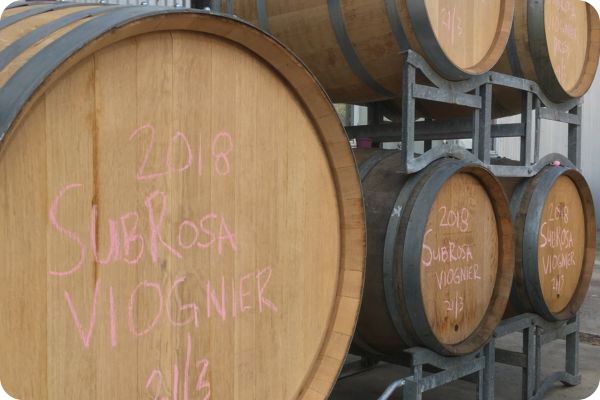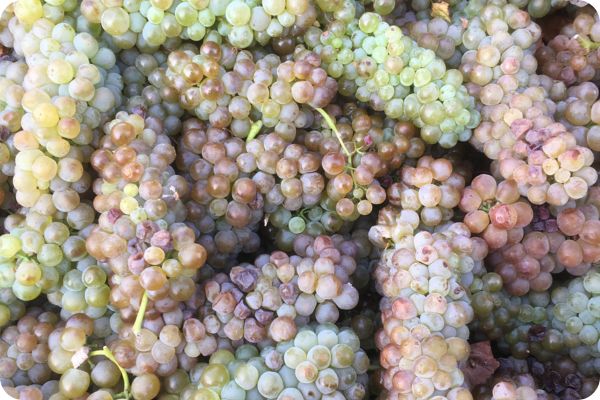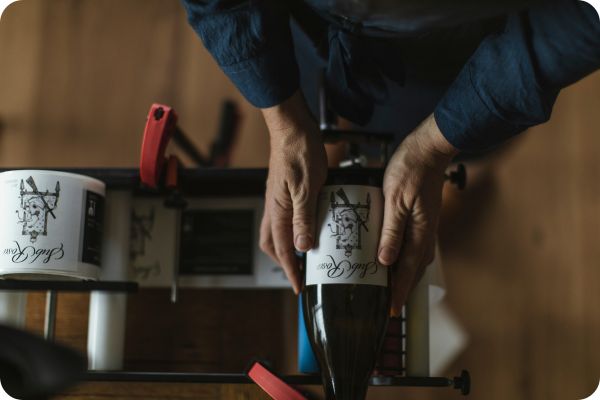Australian Viognier is a hidden gem of the domestic wine world. It accounts for only 1.6% of the total white wine grown in Australia, at approx 765 hectares (source: Wine Australia 2023). It’s a different story in France, the original home of this white wine varietal, with around 8,823 hectares planted. The French clearly know there is something special about Viognier. We do too!
This ultimate guide to Australian Viognier will put this varietal on the map for you. At the very least we think you’ll want to give it a taste. Or if you like it already, make it a more regular bottle in your repertoire.
Fun facts about Australian Viognier
Fun facts about Australian Viognier
– Accounts for only 1.6% of total white wine grown in Australia
– Typical flavour characteristics are ripe apricots, peaches and tropical fruits like mango
– Viognier has a lower acidity than Chardonnay
– Prefers cool climate where ripening is long and slow for its complexity to develop
What are the typical characteristics of an Australian Viognier?
What are the typical characteristics of an Australian Viognier?
Australian Viognier is a distinctive white wine enjoyed for its highly aromatic, floral profile. The dominant notes of ripe stone fruits like apricot and peach are complemented by a silky, smooth texture. As a refreshing balance to its full-bodied nature, subtle undertones of citrus, spices or minerals might be present, enhancing its complexity and depth.
In general, Australian Viognier often presents bolder and more upfront fruit flavours like ripe apricots, peaches, and tropical fruits, reflecting the warmer climates of many Australian wine regions. These wines might also have a slightly richer body and could carry a hint of sweetness, with a vibrant, refreshing acidity that keeps them balanced.
Is Australian Viognier dry or sweet?
Is Australian Viognier dry or sweet?
SubRosa Viognier is dry – but a winemaker can choose to keep some residual sugar if they choose – it’s up to the winemaker.
Why is ours dry?
“Because the fruit has richness and weight and it doesn’t need any residual sugar to balance the wine. Viognier is low acid – you only need residual sugar for high acid varieties like riesling or chardonnay,” says Adam.
How is Viognier different from Chardonnay?
How is Viognier different from Chardonnay?
Flavour profile:
Viognier is more aromatic than Chardonnay, with a pronounced floral and stone fruit character, apricot and peach in particular. Oaked Chardonnays are more buttery, with rich flavours of citrus and apple, depending on the oak influence. In general, oak plays a more dominant role in Chardonnay whereas it imparts a subtle influence on a Viognier.
Fruit characters:
Chardonnay tends to exhibit green apple to tropical notes, while Viognier is more stone fruit like apricots and peaches.
Oak influence:
The impact of oak in Chardonnay tends to be more pronounced, with stronger flavours of vanilla and butter. In Viognier, the use of oak is typically subtler, used to complement rather than mask the grape’s natural aromas.
Body & texture:
Both wines can have a full body, but oaked Viognier retains a distinctive silky texture, while oaked Chardonnay may feel creamier and richer due to malolactic fermentation and the influence of oak.
Acidity:
Chardonnay has higher acidity, which can be softened by oak ageing, while Viognier’s lower acidity combined with oak results in a smooth, silky texture.
Aromatics:
Viognier is more aromatic than Chardonnay, with a pronounced floral and stone fruit character. Chardonnay’s aromas are more subdued and often influenced by the oak, giving it a toasty, caramel nose.

How does Viognier compare to Sauvignon Blanc?
Flavour profile:
The palate of Viognier is typically richer and more lush than Sauvignon Blanc, with stone fruit flavours (like apricot and peach) being prominent. Sauvignon Blanc is a leaner wine, with high acidity, crisp, fresh flavours of melon and beans.
Body & texture:
Viognier is fuller-bodied and creamier, whereas Sauvignon Blanc is lighter and more refreshing.
Acidity:
Sauvignon Blanc is known for its zesty and high acidity, while Viognier is generally lower in acidity and feels rounder on the palate.
Aromatics:
Sauvignon Blanc is more aromatic than Viognier. Sauvignon Blanc is known for its green aromatics, while Viognier is known for its pronounced floral and stone fruit characters.
Temperature:
To get the most out of Viognier’s texture, flavour and aroma, it is best served slightly cooler than room temperature. Sauvignon Blanc is best served cooler, straight from the fridge.
What is the finish of Australia Viognier like?
What is the finish of Australia Viognier like?
Viognier produced with high quality fruit and knowledgeable winemaking will have a long, silky and rich finish.
Where is Viognier originally from?
Where is Viognier originally from?
Historically Viognier is from France’s Northern Rhône region, notable appellations being Condrieu and Château-Grillet. It is typically a blending grape used in both red and white wines.
Which white wine is Australian Viognier similar to?
Which white wine is Australian Viognier similar to?
Viognier is like a more exotic Chardonnay.
Which regions of Australia produce Viognier?
Which regions of Australia produce Viognier?
Cool to moderate climates. Here are some of the major regions by State:
VIC: The Grampians, Yarra Valley, Geelong
SA: Barossa, Eden Valley, Adelaide Hills
NSW: Hunter Valley
What are the best food pairings for Australian Viognier?
What are the best food pairings for Australian Viognier?
Viognier is an extremely food friendly wine. We love it with seafood, particularly prawns and scallops. Thanks to its texture and aromatics, it also matches nicely with poultry, like a roast chicken or lamb straight off the grill.
When it comes to cuisine, we particularly enjoy pairing it with Thai and Indian.
With Thai:
The aromatics of lemongrass are a good match to the peachy aromas of Viognier, while the creaminess of the coconut milk in most of the curries mirrors its lush texture.
With Indian:
Again it’s the aromatic spices. Cumin, coriander, and turmeric, common in Indian dishes harmonise with the floral and spicy notes in Viognier.
In our Guide to Viognier pairing, try the Thai Red Curry with Prawns or Chicken or for an Indian recipe, Oven Baked Tandoori Chicken.

What’s the ideal temperature to serve Viognier?
What’s the ideal temperature to serve Viognier?
Viognier is best served at just below room temperature (11-13C). If it’s too cold, the texture, flavour, acid balance and aromas will be masked. If room temperature is more than 15C, pop your Viognier in the fridge to chill it slightly, but make sure to get it out of the fridge at least 30 minutes before you plan on serving it. It doesn’t need decanting to accentuate its aromatic qualities, it just needs to not be icy cold.
If you have patience and time to let it come to room temperature you’ll be rewarded with flavour and aroma.
For more on serving temperature check out our article Why Temperature Matters.

Why is Viognier so aromatic?
Why is Viognier so aromatic?
The driver of its highly aromatic quality is a combination of its genes, the thickness of the skins and the winemaking process. The Viognier grape, with a thicker skin than most other white wine grapes, has high levels of terpenes, natural compounds found in plants that give them their unique smells and flavours. For example, the fresh scent of pine trees or the sweet smell of flowers. White floral notes like honeysuckle, orange blossom and jasmine are typically associated with the Viognier grape. Intensifying these aromatics is a longer skin contact process during winemaking. The extended time the grape skins remain in contact with the juice extracts a higher degree of aromatic compounds, amplifying the wine’s floral characteristics.
Is Australian Viognier typically oaked?
Is Australian Viognier typically oaked?
Viognier responds positively to oak, adding richness to the texture. However unlike a Chardonnay, oak has a more subtle influence on Viognier where it is used to complement rather than mask the grape’s natural aromas.
Can you cellar or age Australian Viognier?
Can you cellar or age Australian Viognier?
Australian Viognier is best drunk young and fresh. We recommend drinking SubRosa Viognier within six years of its vintage.
Is Australian Viognier blended with any other varietals?
Is Australian Viognier blended with any other varietals?
Viognier adds body, complexity and aromatics to Chardonnay, Marssarne, Roussanne and Shiraz.
What’s the ideal climate for Australian Viognier?
What’s the ideal climate for Australian Viognier?
Viognier prefers a cool climate environment. As the complexity takes time to develop fully, a long, slow ripening season suits it best. It needs warmth to ripen, but not too hot. This is why it does well in cool climate regions like the Grampians, Yarra Valley, Adelaide Hills, the Hunter Valley. The days are warm but the night time temperatures cool significantly, slowing down the ripening process of the Viognier grape.
Is Australian Viognier a difficult grape to grow?
Is Australian Viognier a difficult grape to grow?
Let me direct you to a quote from Wine Australia on growing Viognier:
“It’s challenging to grow and get right in the winery, but in the hands of skilful winemakers, Viognier wine is silky and seductive.”
Now let’s hear from Adam.
“Yes it’s fickle. Likes to be warm, but not too hot. Very short ripeness window making picking tricky.”
Adam how do you known when to pick?
“Whether it’s ripe or not – you just know. At harvest time I’m tasting about 100 grapes a day to determine the ideal moment. For Viognier grapes in particular, if picked too early, the grape lacks flavour – tastes like nothing. If picked too late, the grape tastes like apricot nectar. In the end, I defer to my senses.”
But it’s all worth it! Get it right and the aromatics are spectacular (honeysuckle…) and the delicate yet full-bodied mouthfeel is hard to beat. Viognier can be an absolutely stunning wine.

When is Australian Viognier harvested?
When is Australian Viognier harvested?
The Australian grape harvest season runs from February to April. Due to the long, slow ripening process of Viognier, it is typically harvested in March in the Grampians.
Why is the Grampians a great region for Australian Viognier?
Why is the Grampians a great region for Australian Viognier?
The climate of the Grampians is mild and dry, with moderately warm days and cool nights. This means Viognier enjoys a slow and well-paced ripening, allowing the delicate florals to develop in step with the balancing acidity.
How does the taste of a Grampians Viognier differ?
How does the taste of a Grampians Viognier differ?
In the Grampians, Viognier has a slower, longer growing season than other parts of Australia. It is this cool climate growing season that helps provide additional layers of flavour and texture in the wine.
What are the characteristics of SubRosa Grampians Viognier?
What are the characteristics of SubRosa Grampians Viognier?
Adam is interested in texture, exotic character, expressiveness. This means our Viognier can stand on its own. Yes it’s enjoyable with food, but it’s equally captivating without it. The general characteristics of SubRosa Viognier are:
– Complex and expressive aroma of spiced honey and poached stone-fruits
– Richness of body, texture and fruit, but refined
– Fine acidity, with a finish that is long and elegant
– Varietal character is evident but not overpowering

Adam explains his approach to SubRosa Grampians Viognier winemaking
Adam explains his approach to SubRosa Grampians Viognier winemaking
“I get a lot of pleasure from making Viognier. It’s not a varietal common in Australia but it should be, especially in cool climate regions like the Grampians. It all starts in the vineyard. Picking at the right time is extremely important.
I’m very patient with Viognier, closely managing it through a slow and steady fermentation. I want the innate characteristics of the wine to shine through.”
And for the more technical winemaking details – 100% Grampians Viognier. Picked, pressed and fermented in French oak for 12 months. Lees are stirred to enhance the wine’s texture.
Related Stories



